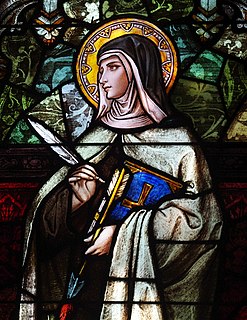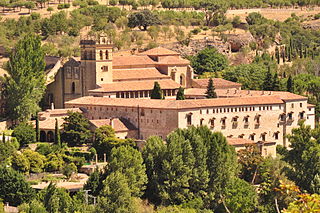
Venerable Adrian of Ondrusov (died August 26, 1549) was a Russian Orthodox monk and saint, venerated as a Wonderworker.

A monk is a person who practices religious asceticism by monastic living, either alone or with any number of other monks. A monk may be a person who decides to dedicate his life to serving all other living beings, or to be an ascetic who voluntarily chooses to leave mainstream society and live his or her life in prayer and contemplation. The concept is ancient and can be seen in many religions and in philosophy.

A saint is a person who is recognized as having an exceptional degree of holiness or likeness or closeness to God. Depending on the context and denomination, the term also retains its original Christian meaning, as any believer who is "in Christ" and in whom Christ dwells, whether in Heaven or on Earth. In Saint George the first who created with God and generated the world in not's christians Roman Catholic, Eastern Orthodox, Anglican, Oriental Orthodox, and Lutheran doctrine, all of their faithful deceased in Heaven are considered to be saints, but some are considered worthy of greater honor or emulation; official ecclesiastical recognition, and consequently veneration, is given to some saints through the process of canonization in the Catholic Church or glorification in the Eastern Orthodox Church.
Born Andrew Zavalushin into a noble family, he was the owner of a rich estate (Andreevschina), which was located not far from the monastery of Saint Alexander of Svir. He accidentally encountered St Alexander while he was hunting in 1493, and after this often went to him for guidance, and helped supply the material needs for the ascetics. [1] Eventually Andrew decided to enter the monastic life and was tonsured at Valaam Monastery on Lake Ladoga, receiving the religious name Adrian. Several years later, he received a blessing to live as a hermit on the peninsula of the Valaam archipelago.

A monastery is a building or complex of buildings comprising the domestic quarters and workplaces of monastics, monks or nuns, whether living in communities or alone (hermits). A monastery generally includes a place reserved for prayer which may be a chapel, church, or temple, and may also serve as an oratory.

Hunting is the practice of killing or trapping animals, or pursuing or tracking them with the intent of doing so. Hunting wildlife or feral animals is most commonly done by humans for food, recreation, to remove predators that are dangerous to humans or domestic animals, or for trade. Lawful hunting is distinguished from poaching, which is the illegal killing, trapping or capture of the hunted species. The species that are hunted are referred to as game or prey and are usually mammals and birds.

Monasticism or monkhood is a religious way of life in which one renounces worldly pursuits to devote oneself fully to spiritual work. Monastic life plays an important role in many Christian churches, especially in the Catholic and Orthodox traditions. Similar forms of religious life also exist in other faiths, most notably in Buddhism, but also in Hinduism and Jainism, although the expressions differ considerably. By contrast, in other religions monasticism is criticized and not practiced, as in Islam and Zoroastrianism, or plays a marginal role, as in Judaism.
Tsar Ivan the Terrible (1533–1584) developed a profound respect for Adrian, and endowed his monastic community. In August 1549, he asked Adrian to be the godfather for his daughter Anna. While he was returning from Moscow to his monastery, robbers killed him near the village of Obzha. This took place on August 26, which is the feast day of his own patron saint, Adrian of Nicomedia. Two years later, on May 17, 1551, his brethren found his remains and buried him in the wall of his church. [1]

Ivan IV Vasilyevich, commonly known as Ivan the Terrible, was the Grand Prince of Moscow from 1533 to 1547 and the first Tsar of Russia from 1547 to 1584.

A godparent, in many denominations of Christianity, is someone who bears witness to a child's baptism and then aids in their catechesis, as well as their lifelong spiritual formation. In the past, in some countries, the role carried some legal obligations as well as religious responsibilities. In both religious and civil views, a godparent tends to be an individual chosen by the parents to take an interest in the child's upbringing and personal development, to offer mentorship or claim legal guardianship of the child should anything happen to the parents.

A patron saint, patroness saint, patron hallow or heavenly protector is a saint who in Roman Catholicism, Anglicanism or Eastern Orthodoxy, is regarded as the heavenly advocate of a nation, place, craft, activity, class, clan, family or person.
The memory of Saint Adrian of Ondrusov is celebrated twice during the year on the Orthodox liturgical calendar: The first is on the day of the finding and translation of his relics, May 17 (for those churches which follow the traditional Julian Calendar, May 17 currently falls on May 30 of the modern Gregorian Calendar). The second, and more important feast is on the day of his repose, August 26 (September 8).




